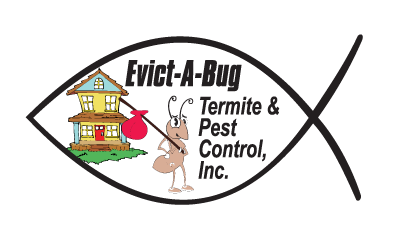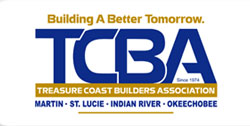Pest Control Services from Evict-A-Bug
We offer Residential and Commercial Pest Control services. We offer both one-time treatments and monthly treatment plans for commercial customers and monthly, bi-monthly, or quarterly treatments for residential customers.
Ants
Ants can be a nuisance both inside and outside the home or office. In our area there a few common types of ants:
Carpenter Ants
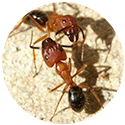 Carpenter ants are among the largest ants found in Florida and also the most common indoor insect pest. Though these ants do not sting they do bite, and it is common to mistake these winged ants for termites. These ants have a fondness for sweets and can be found in campgrounds near soda machines and other areas where sweets are readily accessible. They will hollow out wood softened by moisture and/or fungi to create nests.
Carpenter ants are among the largest ants found in Florida and also the most common indoor insect pest. Though these ants do not sting they do bite, and it is common to mistake these winged ants for termites. These ants have a fondness for sweets and can be found in campgrounds near soda machines and other areas where sweets are readily accessible. They will hollow out wood softened by moisture and/or fungi to create nests.
Pharaoh Ants
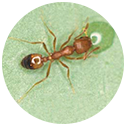 The Pharaoh ant is a major indoor pest in the United States. The ant has the ability to survive most conventional household pest control treatments and to establish colonies throughout a building. More than just the food it consumes or spoils, this ant is considered a serious pest due to its ability for “getting into things.” Pharaoh ants have a wide preference in the types of food consumed. Nesting occurs in inaccessible, warm (80 to 86°F), humid (80%) areas near sources of food and/or water, such as in wall voids.
The Pharaoh ant is a major indoor pest in the United States. The ant has the ability to survive most conventional household pest control treatments and to establish colonies throughout a building. More than just the food it consumes or spoils, this ant is considered a serious pest due to its ability for “getting into things.” Pharaoh ants have a wide preference in the types of food consumed. Nesting occurs in inaccessible, warm (80 to 86°F), humid (80%) areas near sources of food and/or water, such as in wall voids.
Ghost Ants
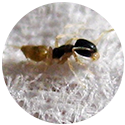 In Florida, this species of insect is the one of the most important household pests. They are easily recognizable due to its peculiar milky color markings and small size. When crushed, the workers emit an odor similar to that of rotten coconuts. The ghost ant can not only invade houses from outside, but they can nest in the house as well. Although the ant feeds upon many household foods, it seems to show a preference for sweets, having been observed feeding on sugar, cakes, and syrups. Outside, the workers scavenge for dead insects and tend sap-sucking insects, collecting honeydew.
In Florida, this species of insect is the one of the most important household pests. They are easily recognizable due to its peculiar milky color markings and small size. When crushed, the workers emit an odor similar to that of rotten coconuts. The ghost ant can not only invade houses from outside, but they can nest in the house as well. Although the ant feeds upon many household foods, it seems to show a preference for sweets, having been observed feeding on sugar, cakes, and syrups. Outside, the workers scavenge for dead insects and tend sap-sucking insects, collecting honeydew.
White Footed Ants
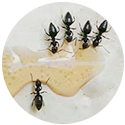 WFA feed on plant nectars and honeydew, which is a sweet substance produced by many sap-sucking insects such as aphids, mealybugs, and scales. The WFA does not bite or sting, nor has it been reported to cause any structural damage. The WFA nests at or above ground level in numerous locations within the landscape and home. Nests are frequently found in trees and bushes, tree holes, under palm fronds and old leaf boots, under leaves on trees, in loose mulch, under debris, in leaf-litter (both on the ground as well as in rain gutters), wall voids, and attics. WFAs are considered by homeowners to be a nuisance pest because they are frequently observed foraging in kitchens, bathrooms, and the exterior of buildings.
WFA feed on plant nectars and honeydew, which is a sweet substance produced by many sap-sucking insects such as aphids, mealybugs, and scales. The WFA does not bite or sting, nor has it been reported to cause any structural damage. The WFA nests at or above ground level in numerous locations within the landscape and home. Nests are frequently found in trees and bushes, tree holes, under palm fronds and old leaf boots, under leaves on trees, in loose mulch, under debris, in leaf-litter (both on the ground as well as in rain gutters), wall voids, and attics. WFAs are considered by homeowners to be a nuisance pest because they are frequently observed foraging in kitchens, bathrooms, and the exterior of buildings.
Bees
Bees are important to our eco-system but sometimes they build their home a little to close for comfort. We make an effort to relocate the bees before exterminating them.
Bumble Bees
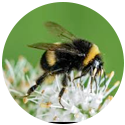 Bumble bees are easily recognized by the corbicula (pollen basket) on the hind area in the females. Most bumble bees are large, social bees which produce annual colonies. These are beneficial insects that pollinate many native and ornamental plants. They can sting severely, so problem nests near human dwellings should be removed by experienced pest control operators.
Bumble bees are easily recognized by the corbicula (pollen basket) on the hind area in the females. Most bumble bees are large, social bees which produce annual colonies. These are beneficial insects that pollinate many native and ornamental plants. They can sting severely, so problem nests near human dwellings should be removed by experienced pest control operators.
Wasps
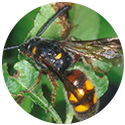 The most commonly known wasps are as yellow jackets and hornets. Adult solitary wasps mainly feed on nectar, but the majority of their time is taken up by foraging for food for their carnivorous young, mostly insects or spiders. Wasp nests made in or near houses, such as in roof spaces, can present a danger as the wasps may sting if people come close to them. Social wasps are considered pests when they become excessively common, or nest close to buildings.
The most commonly known wasps are as yellow jackets and hornets. Adult solitary wasps mainly feed on nectar, but the majority of their time is taken up by foraging for food for their carnivorous young, mostly insects or spiders. Wasp nests made in or near houses, such as in roof spaces, can present a danger as the wasps may sting if people come close to them. Social wasps are considered pests when they become excessively common, or nest close to buildings.
Yellow Jackets
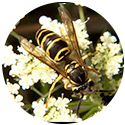 The name yellowjacket refers to the typical yellow and black bands on the abdomen. Yellowjackets do not bite, but have a stinger that injects a very painful venom into the skin. Most of the species of yellowjackets in Florida build underground nests although they can also be found in aerial nests, and typically feed on decaying protein and carbohydrates. They love to visit garbage cans, rotting fruit, rotting meat, and soft drinks. For allergic people, one sting can be deadly. Immediate and aggressive treatment is necessary for people who are allergic to stings. Symptoms include closing of the throat, severe swelling, and hypotension.
The name yellowjacket refers to the typical yellow and black bands on the abdomen. Yellowjackets do not bite, but have a stinger that injects a very painful venom into the skin. Most of the species of yellowjackets in Florida build underground nests although they can also be found in aerial nests, and typically feed on decaying protein and carbohydrates. They love to visit garbage cans, rotting fruit, rotting meat, and soft drinks. For allergic people, one sting can be deadly. Immediate and aggressive treatment is necessary for people who are allergic to stings. Symptoms include closing of the throat, severe swelling, and hypotension.
Chinch Bugs
Chinch bugs are hard to see, but signs include drought-like damage to grass along the driveway and sidewalk, as well as wilting, dried out, yellow-brown blades. Chinch bugs can become resistant to pesticides. If you can’t identify the source but notice such damage call a professional.
Roaches
American Roach
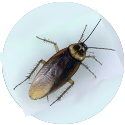 The American cockroach is the largest of the common cockroaches measuring on average 4 cm in length. It occurs in buildings throughout Florida, especially in commercial buildings. The American cockroach is an omnivorous and opportunistic feeder. It consumes decaying organic matter but is a scavenger and will eat almost anything. American cockroaches can become a public health problem due to their association with human waste and disease and their ability to move from sewers into homes and commercial establishments.
The American cockroach is the largest of the common cockroaches measuring on average 4 cm in length. It occurs in buildings throughout Florida, especially in commercial buildings. The American cockroach is an omnivorous and opportunistic feeder. It consumes decaying organic matter but is a scavenger and will eat almost anything. American cockroaches can become a public health problem due to their association with human waste and disease and their ability to move from sewers into homes and commercial establishments.
German Roach
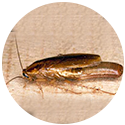 The German cockroach is the cockroach of concern, the species that gives all other cockroaches a bad name. It occurs in structures throughout Florida, and is the species that typically plagues multifamily dwellings. They are unable to survive in locations away from humans or human activity. The major factor limiting German cockroach survival appears to be cold temperatures. German cockroaches adulterate food or food products with their feces and defensive secretions, physically transport and often harbor pathogenic organisms, may cause severe allergic responses, and in extremely heavy infestations have been reported to bite humans and feed on food residues on the faces of sleeping humans. In addition, some scientists suggest that German cockroach infestations may cause human psychological stress and that the stigma associated with infestations alters human behavior.
The German cockroach is the cockroach of concern, the species that gives all other cockroaches a bad name. It occurs in structures throughout Florida, and is the species that typically plagues multifamily dwellings. They are unable to survive in locations away from humans or human activity. The major factor limiting German cockroach survival appears to be cold temperatures. German cockroaches adulterate food or food products with their feces and defensive secretions, physically transport and often harbor pathogenic organisms, may cause severe allergic responses, and in extremely heavy infestations have been reported to bite humans and feed on food residues on the faces of sleeping humans. In addition, some scientists suggest that German cockroach infestations may cause human psychological stress and that the stigma associated with infestations alters human behavior.
Australian Cockroach
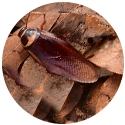 The Australian cockroach is a common species of tropical cockroach. They are peridomestic cockroaches (cockroaches that live mostly outdoors, but occasionally may be found indoors) and the most common cockroach species found outdoors in southern Florida. This species resembles the American cockroach but can be distinguished by the presence of light yellow bands on upper margins of the forewings. Because the Australian cockroach primarily lives outdoors, an IPM approach that includes preventing entry into structures is recommended.
The Australian cockroach is a common species of tropical cockroach. They are peridomestic cockroaches (cockroaches that live mostly outdoors, but occasionally may be found indoors) and the most common cockroach species found outdoors in southern Florida. This species resembles the American cockroach but can be distinguished by the presence of light yellow bands on upper margins of the forewings. Because the Australian cockroach primarily lives outdoors, an IPM approach that includes preventing entry into structures is recommended.
Oriental Roach
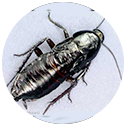 It is also sometimes referred to as the “black beetle” or a “water bug” because of its dark black appearance and tendency to harbor in damp locations. The oriental cockroach is often found feeding on garbage, sewage, or decaying organic matter and will eat almost anything. A diet high in starch is preferred. It will often seek refuge indoors when a drop in temperature occurs, but is still quite tolerable of cooler weather. The species tends to be seasonal, with adults appearing in spring and summer.
It is also sometimes referred to as the “black beetle” or a “water bug” because of its dark black appearance and tendency to harbor in damp locations. The oriental cockroach is often found feeding on garbage, sewage, or decaying organic matter and will eat almost anything. A diet high in starch is preferred. It will often seek refuge indoors when a drop in temperature occurs, but is still quite tolerable of cooler weather. The species tends to be seasonal, with adults appearing in spring and summer.
Brown Banded Roach
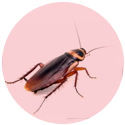 Both adults and nymphs can be distinguished by the two brownish, broad bands across the body at the base of the abdomen and at mid-abdomen. Brownbanded cockroaches prefer warm and dry locations, such as near refrigerator motor housings, on the upper walls of cabinets, and inside pantries, closets, dressers, and furniture in general. Damage by brownbanded cockroaches results from their feeding and harboring in pantries and storage areas indoors. Bacteria and protozoa that cause diseases can be carried on the legs and bodies of cockroaches and deposited on food, utensils, etc. Accurate identification is paramount to controlling brownbanded cockroaches. Control strategies for other cockroaches will not be efficacious for brownbanded cockroaches.
Both adults and nymphs can be distinguished by the two brownish, broad bands across the body at the base of the abdomen and at mid-abdomen. Brownbanded cockroaches prefer warm and dry locations, such as near refrigerator motor housings, on the upper walls of cabinets, and inside pantries, closets, dressers, and furniture in general. Damage by brownbanded cockroaches results from their feeding and harboring in pantries and storage areas indoors. Bacteria and protozoa that cause diseases can be carried on the legs and bodies of cockroaches and deposited on food, utensils, etc. Accurate identification is paramount to controlling brownbanded cockroaches. Control strategies for other cockroaches will not be efficacious for brownbanded cockroaches.
Smoky Brown Roach
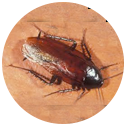 Although closely related to the American cockroach, the smokybrown cockroach is readily distinguishable from it by its uniformly dark brown–mahogany coloration. The smokybrown cockroach can feed off a wide array of organic (including decaying) matter. Like most cockroaches, it is a scavenger. The smokybrown cockroach may come indoors to look for food and even to live, though generally it prefers warmer climates and is not cold-tolerant. It may, however, be able to survive colder climates by going indoors. In addition to this, it fares well in moist conditions and appears to be particularly prevalent in moist concealed areas. It often lives around the perimeter of buildings.
Although closely related to the American cockroach, the smokybrown cockroach is readily distinguishable from it by its uniformly dark brown–mahogany coloration. The smokybrown cockroach can feed off a wide array of organic (including decaying) matter. Like most cockroaches, it is a scavenger. The smokybrown cockroach may come indoors to look for food and even to live, though generally it prefers warmer climates and is not cold-tolerant. It may, however, be able to survive colder climates by going indoors. In addition to this, it fares well in moist conditions and appears to be particularly prevalent in moist concealed areas. It often lives around the perimeter of buildings.
Rodents
Rodents cause massive damage to physical structures and known generally for being unclean, capable of transmitting a wealth of diseases, bacteria and viruses through their feces, saliva and urine. Rodents have the ability to gnaw through a variety of material including cinder block, concrete, and aluminium. Rodent populations can grow very fast, control of them ideally starting before there is a substantial infestation problem.
Spiders
We have hundreds of different spiders here in South Florida but the most deadly ones to keep an eye out for are the Black Widow and Brown Recluse.
Whitefly
Whiteflies feed on the underside of plant leaves, excrete honeydew and cause yellowing or death of leaves. These leaves may be sticky and appear to be covered with black sooty mold that grows on honeydew. Because high populations are difficult to manage, the best strategy is to prevent issues that may develop in your landscape.
*Please note: We do not treat bedbugs.
